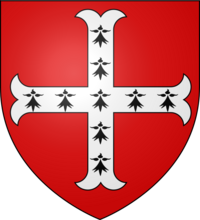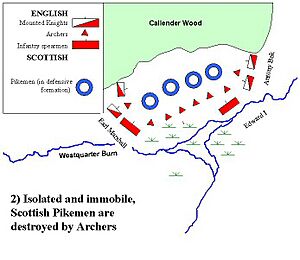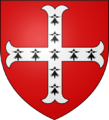Antony Bek (bishop of Durham) facts for kids
Quick facts for kids Antony Bek |
|
|---|---|
| Patriarch of Jerusalem Bishop of Durham |
|

Arms of Antony Bek, Bishop of Durham: Gules, a cross moline (also recerclée) ermine, as blazoned in the Gelre Roll of Arms and the Falkirk Roll of c.1298, listing the knights who fought with King Edward I at the Battle of Falkirk. They appear on his seal and on Episcopal Durham Penny coins minted by him at Durham. These arms are a difference of his paternal arms: Gules, a cross moline (recerclée) argent
|
|
| Elected | 9 July 1283 |
| Enthroned | 25 December 1285 |
| Reign ended | 3 March 1311 |
| Predecessor | Robert of Holy Island |
| Successor | Richard Kellaw |
| Other posts | Archdeacon of Durham |
| Orders | |
| Consecration | 9 January 1284 by Archbishop Willaim Wickwane |
| Personal details | |
| Died | 3 March 1311 Eltham |
| Buried | 3 May 1311 Durham Cathedral |
| Denomination | Roman Catholic |
Antony Bek (born around 1245, died March 3, 1311) was an important English leader. He was a powerful bishop of Durham and also held the special title of Patriarch of Jerusalem. He was a close advisor to King Edward I.
Contents
Antony Bek's Early Life and Rise
Family Background and Education
Antony Bek came from a family of knights. His father, Walter Bek, owned lands in Eresby, Lincolnshire. Antony had two brothers, Thomas and John. Their mother, Eve, was related to the Archbishop of York.
Antony was the third son, born around 1245. Both he and his elder brother Thomas studied at Oxford University from 1267 to 1270.
Starting a Career in the Church
After his studies, Antony joined the church. He quickly gained important positions. By 1275, he was the Archdeacon of Durham. He also held other church roles in places like York, Lichfield, London, and Wells.
His skills caught the eye of Prince Edward, who would later become King Edward I.
Working for Prince Edward
Antony Bek traveled with Prince Edward on a Crusade in 1270. When Edward returned, he gave Bek an important job as Keeper of the wardrobe in 1274. Bek held this role for about a month before his brother Thomas took over.
In 1275, Edward made Bek the constable of the Tower of London. This was a very important position.
Diplomatic Missions
Bek was also a skilled negotiator. In 1277, he helped Edward I make a peace deal with Llywelyn ap Gruffudd, the Prince of Wales. This agreement was called the Treaty of Aberconwy.
He also went to Aragon to arrange a marriage for Edward's daughter, Eleanor. She was to marry Alfonso, the heir to Aragon.
Becoming Bishop of Durham
Election and Consecration
King Edward I helped Antony Bek become the bishop of Durham. He was chosen on July 9, 1283. His official church ceremony, called a consecration, happened on January 9, 1284.
During this ceremony, Bek arranged for the remains of Saint William of York to be moved to a new special place in York Minster. Bek officially took his place as bishop at Durham Cathedral on December 25, 1285.
Involvement in Scottish Affairs
After the King of Scotland died in 1286, Edward I sent Bek to Scotland. Bek was to act on Edward's behalf for the new heir, Margaret of Norway. Margaret was supposed to marry Edward's son.
However, Margaret died soon after. This led King Edward to decide who should be the next Scottish king. Bek played a key role in these discussions. In 1292, Edward chose John Balliol as king. Bek helped with Balliol's crowning ceremony.
Serving King Edward I
Challenges with the Archbishop
In 1293, the Archbishop of York temporarily removed Bek from the church. This happened because Bek allowed the king's officers to arrest two church clerks while he was on a royal mission in Scotland.
A legal case followed, arguing that Bek was acting as the king's officer, not as a bishop. The archbishop eventually gave in and paid a fine.
Seeking Allies for the King
In 1294, King Edward sent Bek on another important mission. He went to Germany to meet with the German king and the archbishop of Cologne. The goal was to find allies for England's war against King Philip IV of France.
Military Campaigns in Scotland
Bek also joined Edward's military campaigns in Scotland. In 1296, he received the surrender of King John I of Scotland at Brechin.
In 1298, Bek led one part of the English army at the Battle of Falkirk. Before the main battle, his troops captured Dirleton Castle.
Disputes and Royal Favor
Around 1300, Bek had a disagreement with the Prior of Durham and the cathedral chapter. They wanted more independence from the bishop. Bek removed the prior and closed the cathedral.
Both sides appealed to the king. The prior had support from some of the king's advisors. The king eventually took away some of Bek's lands in 1301.
In 1303, Bek's lands were returned. But the dispute with the prior continued. More accusations were made against Bek in 1304, including a serious one about imprisoning a royal messenger. This led to his lands being taken again in 1305.
Bek sought help from Pope Clement V. The Pope then gave Bek the special title of Patriarch of Jerusalem in 1306. This stopped further actions against him. King Edward I died in 1307, which also helped Bek.
Service Under King Edward II
After King Edward I died, Bek led his funeral service in 1307. Soon after, the new king, Edward II, gave Bek back his lands and rights.
Bek's title as Patriarch made him the highest-ranking church leader in England. Because of this, he was chosen to investigate the Knights Templar in 1308. In 1309, he finally visited the priory at Durham. The new prior agreed to stop all legal actions against the bishop.
Death and Legacy
Antony Bek died near London on March 3, 1311. He was buried in Durham Cathedral on May 3, 1311.
Bek was a very important advisor to King Edward I for most of his time as bishop. He only lost this role near the end of Edward's reign due to his dispute with the Durham prior.
Bek was known for his grand lifestyle. He had a very large group of followers, including 140 knights. He was also a very rich man. When he died, his personal wealth was worth a lot of money.
He built many impressive buildings, including parts of Auckland Castle, Somerton Castle, and the Great Hall at Durham Castle. After his death, some people tried to have him recognized as a saint, but it did not happen. Bek was also known for his honesty and bravery.
See Also
- Thomas Bek, Bishop of St David's
- Thomas Bek, Bishop of Lincoln
- Antony Bek, Bishop of Norwich
Images for kids



